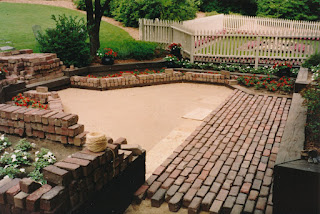Continuing to find my way--the 90s
In the 1980s, I began two very important concepts that go a long way to defining my gardens. First, my front and back lawns evolved into ovals, eventually completely surrounded by plantings, from small to medium to large (except for entrances). I was inspired to do this while visiting Bellingrath Gardens near Mobile, Alabama in the early 1970s. There was a six-acre oval lawn surrounded by plantings of ascending heights. I was awe-struck by this very unnatural scene-- it was better than natural. So, not unusual for me, I copied the concept.Starting in the mid-1980s, I used a single annual flower species in a given location, and I used a single color along with a white variety. I almost did this out of frustration in trying to find good mixes of species and colors. Nothing was just right--often not even close. I believe what finally convinced me this was right for me was a visit to Butchart Gardens in Victoria, British Columbia in 1990. The most famous view of that garden is from high above the flower gardens below. It was quite spectacular--from afar. Then I got close to the scene. One species of annual flowers after the other, often mixed, with varied colors, were very jarring to my eyes. It was similar to being in a large group of people, everyone wearing different colored striped shirts--and different colored plaid pants. Then...I visited their garden where only dahlias were grown, some as high as six feet. I loved it--even though there were many colors. Why, I thought, does this look so much better than the garden that appalled me? It occurred to me that all the green stems and leaves were identical, no matter the flower color, so less violence for my eyes. Eureka! From that point on, I never mixed annual flower species again. I will, however, to a certain extent, mix colors, but only shades of a specific color, such as violet in impatiens in my front yard.
That is the main reason I find so few perennial gardens that I enjoy very much. The colors and textures are, I believe, just too hard to blend well. However, I did visit one such garden on the north side of Milwaukee where the blending was done extremely well, a delightful place.
So, to the photos. The first, from 1990, is of the patio taken from the second story. One color plus white.....but, don't ask me why I alternated pots of red and white that way. Not good! Photo 2 shows the same planting scheme in the front yard in 1991.
Photo 3 shows the oval bed in front of the cobblestone planter in 1991 in grass. Compare that to the last photo, No. 17, planted in Pachysandra by 1999.
In 1992 I re-laid the bricks in the patio, this the second time since installation in 1974. Resting on four inches of sand, they eventually heave a bit. Photo 4 shows that.
Photos 5 & 6 show that by 1994 I was using various shades of violet with impatiens in the front, which I still do.
I rebuilt the RR tie wall in the Sunken Garden in 1995, shown in Photos 7 and 8. It was fun. Each tie only weighs from 180 to 200 pounds--and I did it without help. Can you say surgeon?
After doing that, I had enough ambition to relay the bricks nearby, shown in Photo 9.
Photo 10 shows the layout of the new Terrace Garden, near the back of the lot, started in 1995.
Photos 11-13 show the completion of the Terrace Garden as well as the work near the underground shed and the RR planter
between it and the back lot line, done in 1996. Work in the area continued until 1999, showed in Photo 14.
Photos 15 & 16 shows the extending of the bluestone walk to the north side of the house in 1999 and the gardens to the north lot line (now part of the Japanese Garden).
Well, that's pretty much what the 20th Century looked like in the Sievert garden. (Technically, however, the 21st Century didn't start until January 1, 2001, so I did have one more year.)

















No comments:
Post a Comment